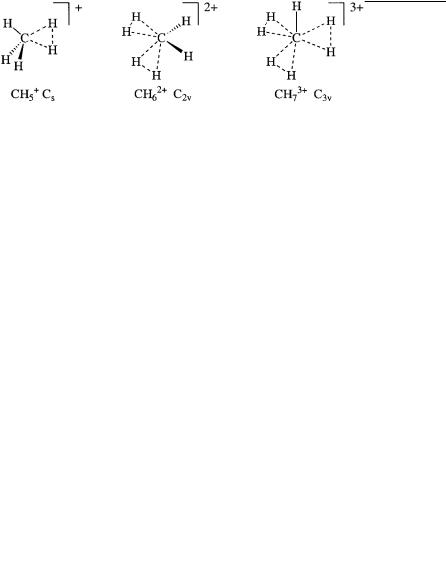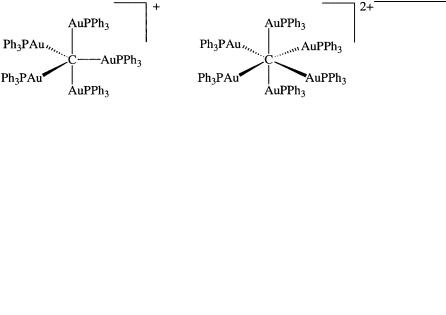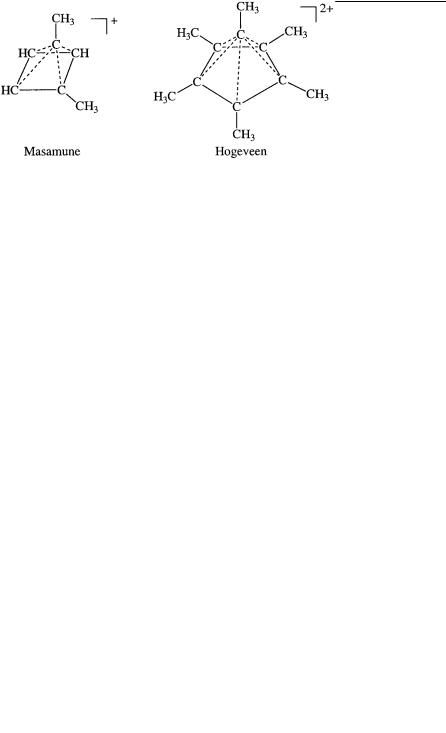
Olah G.A. - A Life of Magic Chemistry (2001)(en)
.pdf
150 A L I F E O F M A G I C C H E M I S T R Y
resent only the extremes of a continuum and that there exists a continuum of charge delocalization comprising both intraand intermolecular interactions.
Neighboring group participation (a term introduced by Winstein) with the vacant p-orbital of a carbenium ion center contributes to its stabilization via delocalization, which can involve atoms with unshared electron pairs (n-donors), -electron systems (direct conjugate or allylic stabilization), bent -bonds (as in cyclopropylcarbinyl cations), and C-H and C-C -bonds (hyperconjugation).
Hyperconjugation is the overlap interaction of an appropriately oriented -bond with a carbocationic p-orbital to provide electron delocalization with minimal accompanying nuclear reorganization. Nuclear reorganization accompanying -bond delocalization can range from little or no rearrangement (hyperconjugation) to partial bridging involving some reorganization of nuclei ( -participation) and to more extensive or complete bridging. Trivalent carbenium ions, with the exception of the parent CH3 , consequently always show varying degrees of delocalization. Eventually in the limiting case carbocations become pentacoordinated carbonium ions. The limiting cases define the extremes of the spectrum of carbocations.
Under superacidic, low nucleophilicity so-called ‘‘stable ion conditions,’’ developing electron-deficient carbocations do not find reactive external nucleophiles to react with; thus they stay persistent in solution stabilized by internal neighboring group interactions.
During my studies I realized that the formation of the -delocalized 2-norbornyl cation from 2-norbornyl precursors represented the equiv-

T H E N O N C L A S S I C A L I O N C O N T R O V E R S Y 151
alent of an intramolecular -alkylation where a covalent C1-C6 bond provided the electrons for the 2e-3c bonded bridged ion (by - participation).
In cases of more effective -electron donor or n-donor neighboring groups, as is the case in forming -phenylethyl (studied by Don Cram from UCLA; Nobel Prize in chemistry, 1987) or -halogen bridged species, these have sufficient electrons to form 2e-2c bonds (with some intermediate delocalization).
The intramolecular -delocalization in the norbornyl system aroused my interest in studying whether similar electrophilic interactions and reactions of C-H or C-C bonds are possible in intermolecular systems. This led to my discovery of the general electrophile reactivity of single bonds (Chapter 10). The long, drawn-out nonclassical norbornyl ion controversy thus led to an unexpected significant new chapter of chemistry. As frequently happens in science, the drive for understanding (for whatever reason) of what appear at the time to be rather isolated and even relatively unimportant problems can eventually lead to significant new concepts, new chemistry, and even practical applications. It justifies the need for exploration and study in the context of fundamental (basic) research even if initially no practical reasons or uses are indicated. The beauty of science lies in finding the unexpected, and, as

152 A L I F E O F M A G I C C H E M I S T R Y
Niels Bohr was frequently quoted to have said, ‘‘you must be prepared for a surprise,’’ but at the same time you must also understand what your findings mean and what they can be used for. To me, this is the lesson of the norbornyl ion controversy. I strongly believe it was not a waste of effort to pursue it, and eventually it greatly helped to advance chemistry to new areas of significance that are still emerging.

10
From Kekule´’s Four-Valent
Carbon to Fiveand
Higher-Coordinate
Hypercarbon Chemistry
One of the cornerstones of the chemistry of carbon compounds (organic chemistry) is Kekule´’s concept, proposed in 1858, of the tetravalence of carbon. It was independently proposed in the same year by Couper who, however, got little recognition (vide infra). Kekule´ realized that carbon can bind at the same time to not more than four other atoms or groups. It can, however, at the same time use one or more of its valences to form bonds to another carbon atom. In this way carbon can form chains or rings, as well as multiple-bonded compounds.
Kekule´ claimed that the concept came to him during a late night ride on a London omnibus in 1854.
One fine summer evening, I was returning by the last omnibus, ‘‘outside’’ as usual, through the deserted streets of the metropolis, which are at other times so full of life. I fell into a reverie and lo! the atoms were gamboling before my eyes. . . . I saw how, frequently, two smaller atoms united to form a pair, how a larger one embraced two smaller ones; how still larger ones kept hold of three or even four of the smaller; whilst the whole kept whirling
153

154 A L I F E O F M A G I C C H E M I S T R Y
in a giddy dance. I saw how the larger ones formed a chain. . . . I spent part of the night putting on paper at least sketches of these dream forms.
—August Kekule´, 1890.
To what degree Kekule´’s recollection was factual we don’t know, but Couper and Butlerov independently had developed similar, more welldefined concepts of valence bonding, which may have not been entirely unknown to Kekule´.
Another of Kelule´’s revelations that supposedly came to him in a dream was his famous structure of benzene. This related to how a carbon chain can close into a ring. To satisfy the four valence of carbon, this, of course, raised the need to involve alternating double bonds.
I was sitting writing at my textbook, but the work did not progress; my thoughts were elsewhere. I turned my chair to the fire, and dozed. Again the atoms were gamboling before my eyes. This time the smaller groups kept modestly in the background. My mental eye, rendered more acute by repeated visions of this kind, could now distinguish larger structures of manifold conformations; long rows, sometimes more closely fitted together; all twisting and turning in snake-like motion. But look! What was that? One of the snakes had seized hold of its own tail, and the form whirled mockingly before my eyes. As if by a flash of lightning I woke. . . . I spent the rest of the night working out the consequences of the hypothesis. Let us learn to dream, gentlemen, and then perhaps we shall learn the truth.
—August Kekule´, 1865.
In this case, we now know that the priority for the benzene structure should at least be shared with the Austrian chemist Loschmidt, whose book discussed much of the same concept but preceded Kekule´’s. Credit, however, for priority in science, as in other fields, is frequently given to a large degree on the basis of how well the claim became known, how widely it was communicated and disseminated. The longevity and staying power of the claimant also help. Couper’s fundamental contribution, for example, is not widely recognized, perhaps because he soon thereafter gave up science and never again pursued it.

H Y P E R C A R B O N C H E M I S T R Y 155
Kekule´’s fame and his extensive contributions to chemistry as a leading German professor of his time certainly overshadowed Loschmidt.
Dreams do not come complete with references and credit to preceding work by others. At the same time, it is also true that realizing the significance of a finding or observation (even if these were originated by someone else) and applying it to a broad concept of substantial significance and lasting importance is a genuine major contribution to science. Of course, I am not saying that proper credit should not always be given to preceding work or publications, but, regrettably, these sometimes tend to be lost over time. People eventually prefer to quote a single, easily available reference of a paper, book, or review, and even if these contain the original references, in subsequent quotations these are frequently not included. The ‘‘dominant’’ reference thus becomes the sole recognized source.
I certainly do not want to minimize Kekule´’s major contributions to chemistry and their significance, but clearly there were—as is generally the case—other contributors who played a significant role and should be remembered.
Kekule´’s four-valent carbon was explained later on basis of the atomic concept and the ‘‘rule of eight’’ valence electrons of the electronic theory of chemistry. From this, G. N. Lewis introduced the electron pair concept and that of covalent shared electron pair bonding (Lewis bond), which Langmuir (Nobel Prize in chemistry, 1932) further developed. It was Linus Pauling (Nobel Prize in chemistry, 1954), and others following him, who subsequently applied the principles of the developing quantum theory to the questions of chemical bonding. I prefer to use ‘‘chemical bonding’’ instead of ‘‘chemical bond,’’ because, after all, in a strict sense the chemists’ beloved electron pairs do not exist. Electrons move individually, and it is only the probability that they are found paired in close proximity that justifies the practical term of covalent electron-pair bonding. Pauling showed that electron pairs occupying properly oriented orbitals (which themselves are the preferred locations, but do not exist otherwise) result in the tetrahedral structure of methane (involving sp3 hybridization). However, neither Lewis-Langmuir nor Pauling considered that an already shared electron pair could further bind an additional atom, not just two.

156 A L I F E O F M A G I C C H E M I S T R Y
In the 1930s, Pauling still believed that diborane had an ethanelike structure and suggested this to Kharash during a visit to Chicago (recalled by H. C. Brown). It was Lipscomb (Nobel Prize, 1976), Pauling’s student, who in the 1950s introduced the two-electron three-center (2e3c) bonding concept into boron chemistry, also explaining the bridged structure of diborane.
It is remarkable that chemists long resisted making the connection between boron and electron-deficient carbon, which, after all, are analogs. I was thus given the opportunity to be able to establish the general concept of five and six coordination of electron-deficient carbon and to open up the field of what I called hypercarbon chemistry.
Organic chemists who are dealing with carbon compounds (or perhaps more correctly with hydrocarbons and their derivatives) have considered 2e-3c bonding limited to some ‘‘inorganic’’ or at best ‘‘organometallic’’ systems and have seen no relevance to their field. The long-drawn-out and sometimes highly personal nonclassical ion controversy was accordingly limited to the structural aspects of some, to most chemists rather obscure, carbocations. Herbert Brown, one of the major participants in the debate and, besides Lipscomb, one of the great boron chemists of our time, was steadfast in his crusade against bridged nonclassical ions. He repeatedly used the argument that if such ions existed, a new, yet unknown bonding concept would need to be discovered to explain them. This, however, is certainly not the case. The close relationship of electron-deficient carbocations with their neutral boron analogs has been frequently pointed out and discussed. Starting in a 1971 paper with DeMember and Commeyras, I pointed out the observed close spectral (IR and Raman) similarities between isoelectronic C(CH3)3 and B(CH3)3 and emphasized the point repeatedly thereafter. My colleagues Robert Williams, Surya Prakash, and Leslie Field did a fine job in carrying the carbocation, borane, and polyborane analogy much further and also reviewed the topic in depth in our book, Hypercarbon Chemistry.
On the basis of my extensive study of stable, persistent carbocations, reported in more than 300 publications, I was able to develop the general concept of carbocations referred to in Chapter 9. Accordingly, in higher-coordinate (hypercoordinate) carbonium ions, of which pro-

H Y P E R C A R B O N C H E M I S T R Y 157
tonated methane CH5 is the parent, besides two-electron two-center Lewis bonding, two-electron three-center bonding is involved.
Extensive ab initio calculations, including recent high-level studies, reconfirmed the preferred Cs symmetrical structure for the CH5 cation, as we originally suggested with Klopman in 1969. The structure can be viewed as a proton inserted into one of the C-H bonds of methane to form a 2e-3c bond between carbon and two hydrogen atoms (or CH3 binding H2 through a long, weaker bonding interaction). At the same time, we already pointed out that ready bond-to-bond (isotopal) proton migration can take place through low barriers to equivalent or related structures that are energetically only slightly less favorable (which led more recently to Schleyer’s suggestion of a fluxional, completely delocalized nature).
With Lammerstma and Simonetta in 1982, we studied the parent six-coordinate diprotonated methane (CH62 ), which has two 2e-3c bonding interactions in its minimum-energy structure (C2v). On the basis of ab initio calculations, with Rasul we more recently found that the seven-coordinate triprotonated methane (CH73 ) is also an energy minimum and has three 2e-3c bonding interactions in its minimumenergy structure (C3v). These results indicate the general importance of 2e-3c bonding in protonated alkanes.
Protonated methanes and their homologues and derivatives are experimentally indicated in superacidic chemistry by hydrogen-deuterium exchange experiments, as well as by core electron (ESCA) spectroscopy of their frozen matrixes. Some of their derivatives could even be isolated as crystalline compounds. In recent years, Schmidbaur has prepared gold complex analogs of CH5 and CH62 and determined their X-ray structures. The monopositively charged trigonal bipyramidal

158 A L I F E O F M A G I C C H E M I S T R Y
{[(C6H5)3PAu]5C} and the dipositively charged octahedral gold complex {[(C6H5)3PAu]6C}2 contain fiveand six-coordinate carbon, respectively. Considering the isolobal relationship (i.e., similarity in bonding) between LAu and H , the gold complexes represent the isolobal analogs of CH5 and CH62 .
The remarkable stability of the gold complexes is due to significant metal-metal bonding. However, their isolation and structural study are remarkable and greatly contributed to our knowledge of highercoordinate carbocations.
Boron and carbon are consecutive first-row elements. Trivalent carbocations are isoelectronic with the corresponding neutral trivalent boron compounds. Similarly, pentavalent monopositively charged carbonium ions are isoelectronic with the corresponding neutral pentavalent boron compounds. BH5, which is isoelectronic with CH5 , has also C8 symmetrical structure based on high-level ab initio calculations. Experimentally, H-D exchange was observed in our work when BH4 was treated with deuterated strong acids, indicating the intermediacy of isopomeric BH5. The first direct experimental observation (by infrared spectroscopy) of BH5 has only recently been reported. The X-ray structure of the five-coordinate gold complex [(Cy3P )B(AuPPh3)4] was also reported by Schmidbaur. This square pyramidal compound represents the isolobal analog of BH5, and further strengthens the relationship of the bonding nature in higher-coordinate boron and carbon compounds.
Similarly, as fiveand six-coordinate CH5 and CH62 are isoelectronic with BH5 and BH6 , respectively, seven-coordinate tripositively charged CH73 is isoelectronic with the corresponding dipositively charged heptavalent boronium dication BH72 . We have also searched for a minimum-energy structure of tetraprotonated methane, CH84 .

H Y P E R C A R B O N C H E M I S T R Y 159
However, CH84 remains even computationally elusive because chargecharge repulsion appears to have reached its prohibitive limit. The isoelectronic boron analog BH83 , however, was calculated to be an energy minimum.
As shown in studies of CH5 , CH62 , and CH73 and their analogs, carbon, despite its limiting tetravalence, can still bond simultaneously to five, six, or even seven atoms involving two-electron three (or multi)- center bonds. Such carbon atoms are called hypercarbons (short for hypercoordinated carbon atoms).
Because carbon is a first-row element unable to extend its valence shell, hypervalence cannot exist in carbon compounds, only hypercoordination.
Hypercarbon compounds contain one or more hypercoordinated carbon atoms bound not only by 2e-2c but also 2e-3c (or >3c) bonds.
The discovery of a significant number of hypercoordinate carbocations (‘‘nonclassical’’ ions), initially based on solvolytic studies and subsequently as observable, stable ions in superacidic media as well as on theoretical calculations, showed that carbon hypercoordination is a general phenomenon in electron-deficient hydrocarbon systems. Some characteristic nonclassical carbocations are the following.
